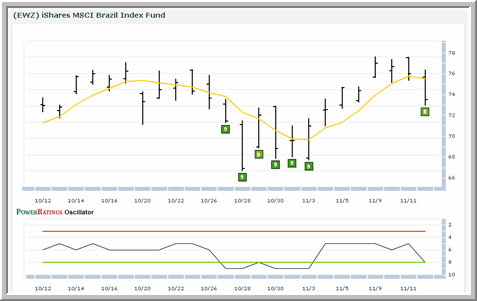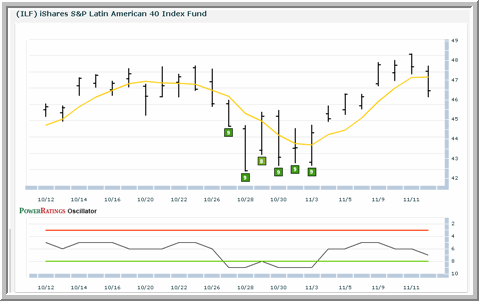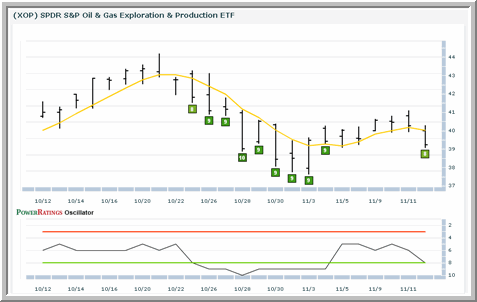ETF PowerRatings Trading Strategies: Pullbacks in Brazil, Latin America, Energies
Days of overbought conditions have finally brought out profit-takers in earnest, helping drive lower a number of exchange-traded funds (ETFs) in a variety of markets.
All three of the exchange-traded funds in today’s report have ETF PowerRatings of 7 or 8. Our research, going back to 2003, shows that exchange-traded funds that earn ETF PowerRatings of 8 have made significant short term gains more than 77% of the time. This makes 8-rated ETFs the kind of potential opportunity that should be at the core of any high probability ETF trading strategy. Even 7-rated ETFs made short-term gains nearly 75% of the time after receiving their PowerRatings upgrades.
For more information about our new ETF PowerRatings, click here.
When it comes to making the best of our PowerRatings trading strategies, we always like to look to country ETFs first. We have found that country ETFs, exchange-traded funds that represent the top equities of a given country or geographic region, have consistently performed as well or better than other ETFs, such as sector or commodity ETFs.
Friday morning brings us three different ways to take advantage of this tendency toward outperformance among country ETFs. First up is the iShares MSCI Brazil Index Fund ETF
(
EWZ |
Quote |
Chart |
News |
PowerRating), which closed on Thursday with a 2-period RSI of less than 15 and an ETF PowerRating of 8.

Down more than 3% on Thursday, EWZ closed at its lowest level in five days. The ETF had reached overbought extremes above the 200-day moving average as recently as Monday.
Sticking with the Southern Hemisphere – at least for the most part – the iShares S&P Latin America 40 ETF
(
ILF |
Quote |
Chart |
News |
PowerRating) has earned an ETF PowerRating upgrade to 7 as of Friday’s open.

ILF pulled back by more than 2% on Thursday, creating a new short-term, oversold low above the 200-day moving average. Additional weakness here – as with EWZ – will likely result in even more gains to its ETF PowerRating, and potentially greater opportunity for high probability traders.
A last note on energies. The pullbacks in energy ETFs are pronounced. Here is a list of some of the oversold energy ETFs going into Friday’s trading.
PowerShares DB Oil Fund
(
DBO |
Quote |
Chart |
News |
PowerRating)
ProShares Ultra Oil & Gas ETF
(
DIG |
Quote |
Chart |
News |
PowerRating)
iShares Dow Jones U.S. Oil & Gas Exploration & Production Index Fund ETF
(
IEO |
Quote |
Chart |
News |
PowerRating)
iShares Dow Jones U.S. Energy Sector Index Fund ETF
(
IYE |
Quote |
Chart |
News |
PowerRating)
Oil Service HOLDRS ETF
(
OIH |
Quote |
Chart |
News |
PowerRating)
iPath S&P Goldman Sachs Crude Oil Trust Index ETN
(
OIL |
Quote |
Chart |
News |
PowerRating)
United States Oil Fund
(
USO |
Quote |
Chart |
News |
PowerRating)
Energy Select Sector SPDR ETF
(
XLE |
Quote |
Chart |
News |
PowerRating)
Vanguard Energy ETF
(
VDE |
Quote |
Chart |
News |
PowerRating)
SPDR S&P Oil & Gas Exploration & Production ETF
(
XOP |
Quote |
Chart |
News |
PowerRating) (below)

That’s a lot of oversold energy exchange-traded funds.
Sector-based funds – even those linked strongly to commodities – have performed well in our high probability strategies and our ETF PowerRatings still help signal which ETFs are more likely to make significant short term gains.
The danger here, however, is that commodity-based ETFs have a tendency to run compared to other ETFs. By this, I mean that these funds often do not revert to the mean with the same regularity and reliability as other ETFs such as country ETFs, and equity index ETFs. Traders who take advantage of pullbacks in these sector ETFs with a strong commodity component, should be aware of this possibility and adjust their trading strategies accordingly.
David Penn is Editor in Chief at TradingMarkets.com.
